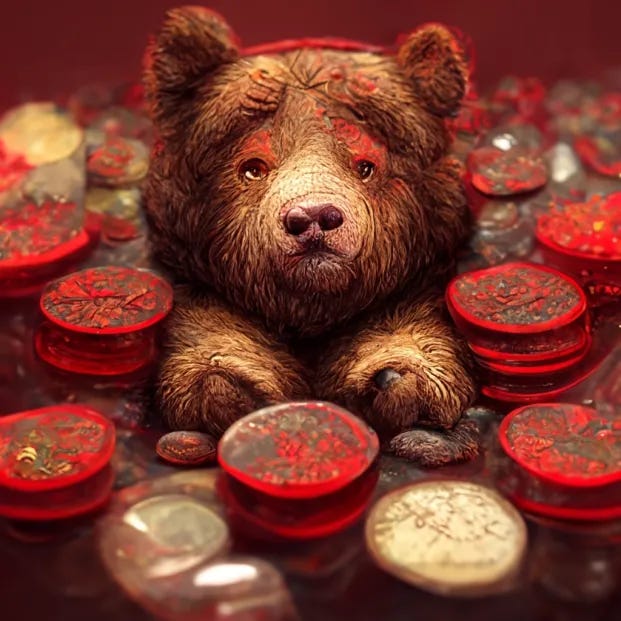Building a Better Web in a Chaotic Bear Market
How to Disassociate Your Web3 Brand from the Crypto Collapse and How Subscription Models Could Potentially Save Us
Unless you lived under a rock the past month, it’s hard to ignore the media headlines surrounding centralized crypto markets like FTX and Gemini. It feels like the entire Web3 industry is in crisis PR mode, even though crypto does not equate to web3.
Web3 is about putting tech, data, finances, and everything else back into the control of the communities.
And whether you’re a Fortune 500 company exploring smart contracts or a Web3 native decentralized autonomous organization (DAO), it’s the communities and connections we made over the years that will get us through the bear markets.
Web3 is more than the speculative trading surrounding it.
Non-fungible tokens (NFTs) gained a huge buzz over the last few years, growing to an $11.3 billion market last year, with some analysts predicting it’ll grow as large as $231 billion by 2030. But those prices don’t reflect what’s actually happening in the NFT space to fuel them – the most successful NFTs provide entry into an exclusive community, along with an opportunity to curate ideas, products, and services for a captivated audience.
The fear around NFTs is understandable–crypto is in a bear market while the global economy faces recession, inflation, and unprecedented disruption in the pandemic’s wake. Some centralized exchanges were houses of cards, and those who don’t follow the rules are losing everything overnight. But what’s happening in these markets is separate from the token-gated communities thriving in Discord and Telegram.
Although the crypto market was turbulent over the past year (and will continue to be moving forward, thanks to bad apples like SBF), decentralized communities are still going strong. Owning an NFT is more valuable than the market cap of the crypto market itself, and some very savvy startups are leveraging those technologies to build large communities hidden far away from Google and Bing search crawlers.
Thousands of well-funded NFT launches from the peak are still nurturing their communities. Game7, for example, is building the future of Web3 gaming, while Bankless DAO built a decentralized media empire that easily rivals legacy news desks. In every industry, we are seeing decentralized organizations building around NFTs to build tokenized communities with true real-world utility and value.
There’s a real, sustainable business model that can be built around it too.
Some big brands figured out how to maintain interest in their NFT projects by selling merch and offering deals, much like an Amazon Prime subscription or even subscription box services like Birchbox. The global lockdowns increased consumer subscriptions by about 89% from 2020-2021 as consumers shifted from a “should try” to a “must have” mentality. Today, an estimated 68% of people have a subscription for household staples ranging from personal hygiene and pet supplies to food and beverage.
So, how can brands take advantage of this subscription mentality to build a path forward in Web3 that’s distinct from the empty markets?
Let’s dive in.
Supporting a Digital Community
Starbucks was late to the NFT party, but its September 12th Starbucks Odyssey waitlist launch showed the coffee giant took that time to ensure it actively supports their current vision. The web3 initiative lets Loyalty Club members and company employees engage in a series of games and challenges to earn collectible digital “journey stamp” NFTs.
The company has a long history of offering limited-edition merchandise and drinks (like the ever-popular Pumpkin Spice Latte), and founder and interim CEO Howard Schultz explained the company is laser-focused on appealing to Gen Z. It can extend the existing Starbucks loyalty program to attract new customers and offer a broader set of rewards attached to each NFT.
Tying NFTs to limited-edition merch is nothing new either; RTFKT made a name for itself by raining down limited buying opportunities of drool-worthy loot like its recent CloneX collection that includes bespoke Nike Air Force 1 sneakers inspired by CloneX “DNA.” Nike even spent a rumored $1+ billion on the RTFKT acquisition because they understand the importance of owning, shaping, and pioneering the future of best-in-class digital strategies.
And we’re already seeing NFTs being tied to lifetime subscriptions. TIME, which is about to celebrate 100 years in business, launched its TIMEPieces NFT collection last year. It includes over 20,000 NFTs featuring photography and digital art from 89 emerging Web3 artists, like Joanne Hollings and Julie Pacino. Each NFT comes with unlimited digital access to TIME content, along with invitations to exclusive virtual and IRL events for as long as the NFT is held in your wallet.
Once you sell the NFT, the rights transfer to the new owner, and TIME earn a commission off those secondary sales, helping them generate $10 million in profits, along with raising $600,000 for charities. This hints at the future of NFTs as a lifetime deal (LTD) in a world of subscription payments.
Why Subscriptions Work
Let’s cut to the chase…subscription boxes as a business model by themselves have proven shaky. Blue Apron was on the verge of bankruptcy until the pandemic lockdowns repopularized food delivery. Loot Crate went bankrupt in 2019 and was acquired by collectibles manufacturer NECA. Of course, this doesn’t mean the model is broken; in fact, NECA purchased Loot Crate for predictable monthly revenue from long-term customers.
But the Subscription Economy grew by over 435% in the nine years leading into the pandemic. Businesses prefer subscription models because they deepen customer relationships, and some even write off losses as a marketing expense. In choosing to be a customer, NFT holders essentially receive free digital samples of curated products that can, in turn, convert them into higher-ticket buyers.
Take Costco, for example; the members-only warehouse store has sold a hot dog and soda combo for $1.50 since the mid-1980s. Despite inflation over the last 35 years, it took whatever steps were necessary to keep the price stable, and it paid off by contributing to the company’s 93% retention rate. Because 80% of the company’s revenue comes from membership fees, it can afford to lose some money in the cost of some perks.
Attaching NFTs to the concept makes for an even more mouth-watering deal for consumers who may be suffering from subscription overload. There’s also the model AMC used to keep itself relevant in a post-memestonk era.
Unlike Gamestop, AMC embraced its large, decentralized retail investor base by offering exclusive deals like free popcorn, early entry into blockbuster hits, and regular vanity NFTs for its investors. The NFT, in this case, is more just a badge for traditional stockholders, but it deepens the community relationship in a way few legacy brands have accomplished.
In an Everything-as-a-Service world, NFTs provide a sense of permanent ownership that we don’t really have anywhere else. It seems like everything from our homes to our cars and lifestyles are rented on an as-needed basis.
Nowadays, everything is a subscription, from hardware and software to movies, music, food, and even clothing. The average person spends $219/month on subscriptions, many of which they often forget about. This includes mobile phones, internet, streaming services, gaming, news, and memberships, like Amazon Prime and Costco.
NFTs can remove the subscription to instead provide a one-time lifetime deal (LTD) payment. LTDs are what kept marketplaces like AppSumo in business for the last decade as businesses scramble to reduce expenses while remaining productive. LTDs eliminate monthly subscription costs, and if consumers need liquidity, they can always sell their NFT. Because the company earns a commission from the NFT sale, every lost customer is a new acquisition.
It doesn’t need to be an LTD–NFTs can be set up to require a new token every year or even month to retain membership, as DAO Central does. Using similar mechanics to BAYC/MAYC Serum or CryptoKitty breeding, you can airdrop to token holders and require the latest month’s/year’s token to access services. My BFF has been killing it on this route by giving its friendship bracelet NFT holders a MyBFF profile pic (PFP) NFT along with limited-edition charms for participating.
An experienced smart-contract developer can help you make any of these business models a reality, or you can create your own personalized model using the individual elements of each that best apply to your brand.
The Future of Web3 Is Now
It’s becoming increasingly clear that we need to differentiate the progress being made in Web3 from the destructive behaviors like speculative trading in cryptocurrencies. NFTs are more than just a number on a graph, and it takes more than a pretty jpeg to successfully launch a Web3 business and brand.
Established legacy companies like TIME, Nike, and Starbucks have already proved that NFTs can boost loyalty and revenue while building deeper connections between brands and their customers. Their NFTs aren’t about money–they’re about providing real value to token holders and building a community, and it’s a long-term play that deepens their existing relationships.
Moving forward in 2023, I expect the media will eventually tire of what’s sure to be a decade-long SBF saga. It’s not the large vanity numbers on trading charts that truly defines Web3–that’s all day-trader stuff that belongs in r/WallStreetBets.
What will define Web3 is the community-owned and community-led projects that are revolutionizing modern business.
If you aren’t sure how to differentiate your brand’s NFT or Web3 project from the FTX/SBF debacle, contact us to let ZEITG3IST pave the road forward into the next generation of digital communities.
Lena Grundhoefer is the Founder of ZEITG3IST, a globally-recognized strategy agency. As we provide future-proof marketing for the brands of tomorrow, we help Fortune 500 brands, as well as brands just starting out, break into web3.







